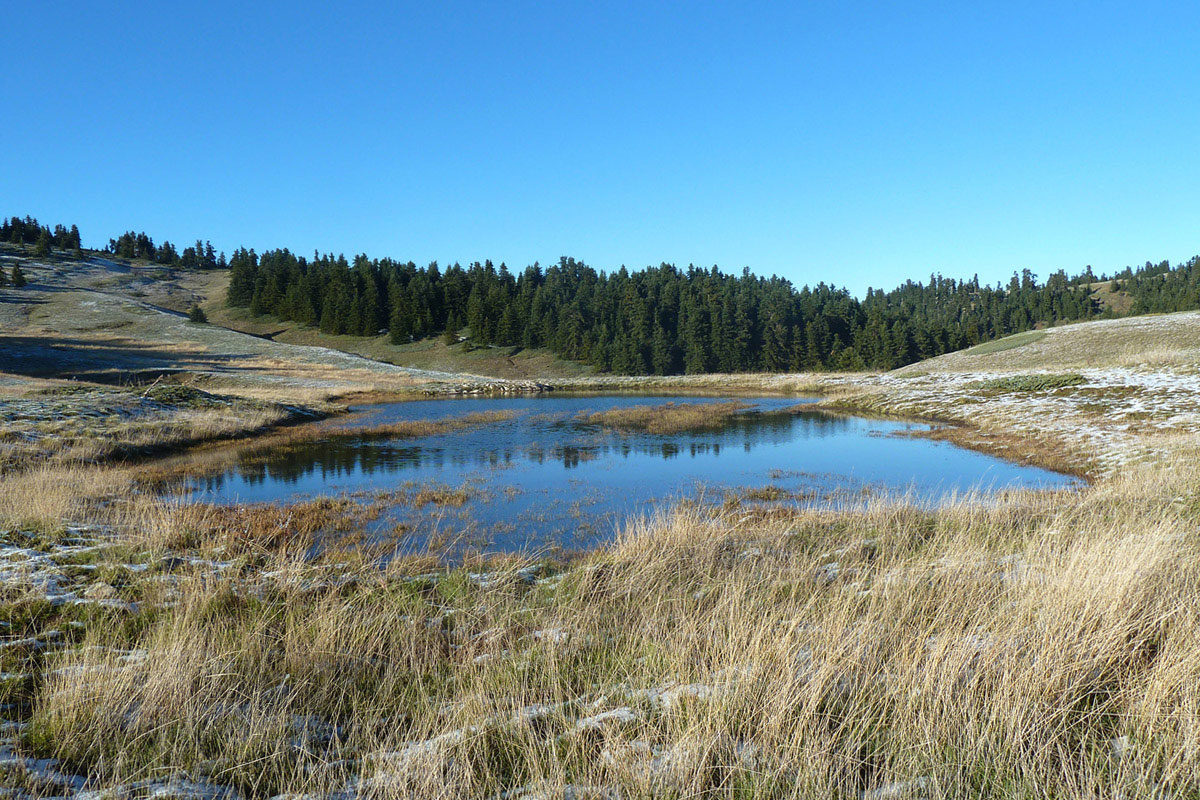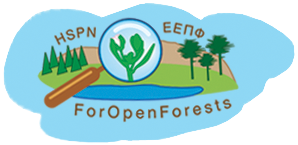
The main objective of the project is the implementation of management of forests and forest openings for the conservation of biodiversity at species, habitat, and landscape level in two mountainous Natura 2000 sites of Central Greece, in the Region of Sterea Ellada: "Ethnikos Drymos Oitis” (GR2440004) and “Oros Kallidromo” (GR2440006).
The target habitats of the project are:
Annex I 92/43/EEC priority habitats:
- Endemic Mediterranean forests with Juniperus foetidissima (habitat type 9560*),
- Mediterranean pine forests with endemic black pines (habitat type 9530*),
- Semi-natural dry grasslands on calcareous substrates (Festuco Brometalia) (*important orchid sites) (habitattype 6210*),
- Species-rich Nardus grasslands, on siliceous substrates in mountain areas (habitat type 6230*),
- Mediterranean temporary ponds (habitat type 3170*).
The target species are:
Annex II Directive 92/43/EEC priority species:
- Veronica oetaea* a critically endangered temporary pond species,
- Brown Bear (Ursus arctos*) a threatened forest species.
Annex I Directive 79/409/EEC birds:
- Tengmalm’s Owl (Aegolius funerus),
- Black Woodpecker (Dryocopus martius),
- White-Backed Woodpecker (Dendrocopus leucotos),
- Grey-headed Woodpecker (Picus canus),
- Rock Partridge (Alectoris graeca).
The main objective of the project will be achieved by the following series of specific goals, which have been set after investigation of the threats for the target habitats and species in the project sites:
- Maintenance of forest openings in order to conserve the mountain grasslands and temporary ponds.
- Restoration of the hydrogeology and of the biotic communities of the temporary ponds, including enhancement of the population of Veronica oetaea*.
- Protection of the grasslands and temporary ponds from degradation caused by human pressure.
- Restoration of the Juniperus foetidissima forests, including restoration of the regeneration potential and expansion of the area of occurrence.
- Protection of the conifer forests from destructive wild fires.
- Ex situ conservation of the target habitats and plant species.
- Enhancement of the population, expansion of the area of occurrence, and protection of the five Annex I bird species.
- Enhancement and protection of the population of the Brown Bear.
- Active involvement of the stakeholders in conservation management.
- Legal protection of the project sites.
Actions and means involved:
1. A series of preparatory actions (actions A) will provide sound, scientifically based specifications for the concrete conservation and dissemination actions. Actions A.1, A.2, A.3, A.4, A.5, A.6, A.7, A.9, and A.10 include studies of the target habitats and species and investigation of the factors influencing them. These actions will also provide the initial status of the target habitats and species, as well as specifications for monitoring the impact of the conservation actions on them (actions D). Action A.8 will provide specifications for interventions mainly related to access control and infrastructure. Actions A.11 and A.12 include investigation of stakeholders’ opinions and expectations, as well as determination of the governance structure and of the legal status of the target habitats and species. These actions will provide a concrete basis for ensuring the consent and involvement of the stakeholders.
2. The concrete conservation actions (actions C) will implement the project objectives set.
- The maintenance of forest openings will be achieved by implementing grazing management regimes and woody vegetation clearing (action C.3). The effects of the implementation of various degrees of grazing in combination with various regimes of vegetation clearing on the habitat quality of mountain grasslands and temporary ponds will be investigated, and the appropriate management for biodiversity conservation will be determined. These practices will also restore habitat quality of the target habitats by restoring the vegetation composition and structure.
- The hydrogeology of the temporary ponds will be restored by removal of modifications, and by erosion control which will inhibit sedimentation (action C.4). Also access control measures and the creation of visitor infrastructure (action C.1) will prevent trampling which causes soil compaction, pollution and increase of nitrates by leaching due to waste disposal, as well as increase of nitrates caused by grazing animals.
- The restoration of the temporary pond biotic communities will be achieved by the above interventions, but also by direct interventions on the biotic communities (action C.4), such as removal of competitors and re-introduction of the characteristic species. In addition, pilot introduction of Veronica oetaea* at new sites will be implemented (action C.2).
- Restoration of the Juniperus foetidissima forests will be achieved by producing and planting male/female/dioecous plants in order to ensure a favourable sex ratio; by protecting young plants; and by pilot re-introduction of the habitat at two new sites (action C.5).
- The protection of Juniperus foetidissima forests and Pinus nigra forests from wild fires will be achieved by enhancement of the fire protection infrastructure (action C.6) and also by reducing the occurrence of accidental fires through visitor control measures (creation of camping and recreation sites).
- Ex situ conservation of the target habitats and plant species will be achieved by establishing a seed-bank of the keystone species, and by developing methods for their propagation and outplanting (action C.7). This action will also provide the plant material for restoration actions C.2, C.4 and C.5.
- Enhancement of the population, expansion of the area of occurrence, and protection of the five Annex I bird species (action C.8) will be achieved by: conservation of natural nesting sites and of food resources (preservation of old trees and of dead wood); increase of nesting sites through installation of nesting boxes; application of favourable forestry practices; preservation of the feeding sites in grasslands.
- Enhancement and protection of the population of the Brown Bear (action C.9) will be achieved by: minimising conflict with producers through the distribution of Hellenic Livestock Guarding Dogs and electric fences for apiaries, thus minimising human induced mortality; preserving and enhancing wild fruit trees.
- Legal protection of the project sites will be achieved by: the preparation of two legal documents which will establish the legal framework necessary for the conservation and management of Mt. Oiti and Mt. Kallidromo Natura 2000 sites and surrounding areas; and by the adoption of the relevant legislation by Ministry for the Environment, Energy and Climate Change.
3. The impact of the concrete conservation actions on the target habitats and species will be monitored by the D actions. Regular monitoring will allow for amendments to the specifications of the conservations actions if necessary.
4. The dissemination actions (actions E) will:
- Disseminate the results of the project to the general public, to site managers, and to the scientific community by: establishing a project website (action E.3); the presentation of the results at conferences; publications in scientific journals and bulletins; participation in specialised scientific groups (action E.5).
- Ensure the assent and consent of the stakeholders and encourage their involvement in conservation through local events, educational seminars, and training workshops (actions E.1, E.4). This will contribute to the after-LIFE maintenance of the results of the project.
- Achieve public education and raise public awareness by: distributing informative/educational material; issuing information in the mass media (action E.1); establishing education and information centres (action E.2).
5. A series of overall coordination and management actions (actions F) will facilitate the project operation and facilitate communication with stakeholders and with other interested site users, and will ensure the continuation of conservation actions after the end of the project.
- Action F.1 will establish a clear management structure headed by the Project Manager; it will ensure adherence to the schedule, timely production of good quality deliverable products and fulfilment or reporting obligations to the EU; and will ensure good financial administration, assisted by external auditing (action E.3).
- The Stakeholder Committee (action F.2) is an important element of the project operation and for achieving the project objectives. It represents the means of direct stakeholder involvement in the project, and will provide guidance in order to ensure public support and commitment and to overcome potential administrative and political problems. It will also be instrumental in producing the after-LIFE habitat and species conservation plan (action F.4).
- Networking with similar projects (action F.5) will achieve exchange of information and experience in the management of target habitats and species.













